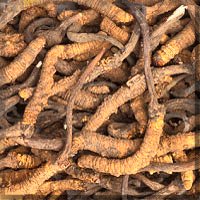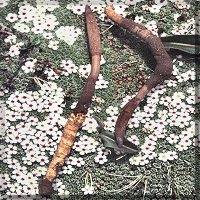

Cordyceps sinensis


Cordyceps sinensis
Synonyms - Tochukaso/Tohchukaso, Caterpillar Fungus, Dong Chong, Xia Cao Tochukas, Deer Fungus
Description - Cordyceps is a unique black, blade-shaped fungus found primarily at high altitude on the Qinghai-Tibetan plateau. The fungus is parasitic, growing on and deriving nutrients from several species of caterpillar, although primarily that of the moth Hepialus armoricanus Oberthur, which lives 6 inches underground (Chen and Jin, 1992; Yin and Tang, 1995). In late autumn, chemicals on the skin of the caterpillars interact with the fungal spores and release the fungal mycelia, which then infect the caterpillar. By early summer of the following year, the fungal infestation has killed the caterpillar and the fruiting body can be seen protruding from the caterpillar's head. This wild form, Cordyceps sinensis, is harvested, whereas the principal fungal mycelium of Cordyceps sinensis, known as Paecilomyces hepiali Chen, is cultivated aseptically (Yue et al., 1995). Because natural Cordyceps (wild Cordyceps sinensis) is rare, Chinese scientists have extensively examined its life cycle with the aim of developing a technique for isolating fermentable stratus of Cordyceps sinensis.
Pharmacology - The stroma (sporocarp ( fruiting body)) of the fungus grows above ground in spring to facilitate spore dispersal. The stroma grows out of the head of the former caterpillar, which otherwise would overwinter buried deep in grass or other perennial roots. The caterpillars, if not taken over by Cordyceps, would grow into a small white ghost moth [Thitarodes (Hepialus) spp.]. Cordyceps contains a wide variety of potentially important constituents, including polysaccharides, ophiocordin (an antibiotic compound), cordycepin, cordypyridones, nucleosides, bioxanthracenes, sterols, alkenoic acids, and exo-polymers.
Cordyceps fungus has the ability to increase the ATP (adenosine tri-phosphate) production in human cell's mitochondria, thus increasing the energy levels of people using it. ATP is similar to GMT, which is Guanine (derived from guano), and is necessary in the production of triphosphates, which is one of the end results of the medication - Aciclovir (Zovirax and Zovir) treatment for human Herpes viruses (including Herpes simplex virus types 1 and 2 and Varicella zoster virus (VZV), Epstein Barr virus (EBV) and Cytomegalovirus (CMV)) in having phosphorylated monophosphates to active triphosphates!
Compounds found in cordyceps are classified as HDP "Host Defense Potentiators". These compounds include: hemicellulose, polysaccharides, polysaccharide-peptides, nucleosides, triterpeniods, complex starches, and other metabolites. Combinations of these compounds are now believed to target the human immune system as well as aid in neuron transmission, metabolism, hormonal balance and nutrient and oxygen transport. They support the development of lymphoid stem cells and other important body defense responses.
Seven Classes of Chemical Constituants of Natural Cordyceps:
Medicinal use - Clinically, Cordyceps is used to build and support immune function in various immune compromised conditions including chronic fatigue, cancer, and respiratory conditions, especially asthma and the treatment of chronic hepatitis B, poor renal function, and renal injuries by chemicals.
The strain Cs-4 from wild Cordyceps sinensis (Berk.) Sacc. Cs-4 has been used to produce a fermented product of the mycelia of Paecilomyces hepiali Chen and contains pharmacologically active components similar to those of the natural Cordyceps. Since its successful isolation in 1982, the Cs4 fermentation product has been studied intensively in China. Industrial fermentation methodology (resulting m a commercial product, JinShuiBao capsule). Chemical composition, therapeutic functions, and toxicity have been thoroughly investigated, and basic research in animals has carried out. JinShuiBao capsule, the Cs-4 fermentation product, has received approval by the National New Drug Review and Approval committee of the Chinese Ministry of Public Health, and has been used in clinics throughout China.
Contra-indications - It is a pure, natural nutriment, beneficial to the weak and patients of chronic renal failure, and has not been known to be toxic or have any known side effects and can be taken over a long period of time. There is no information available about safety in pregnancy, lactation, or use in children.